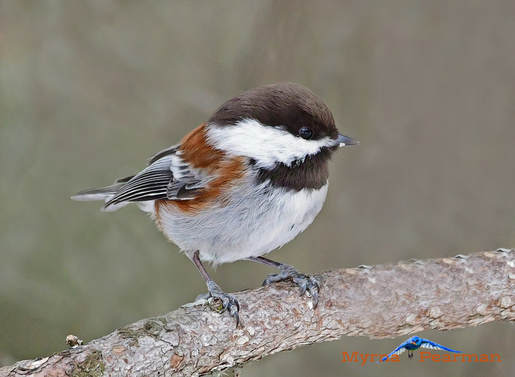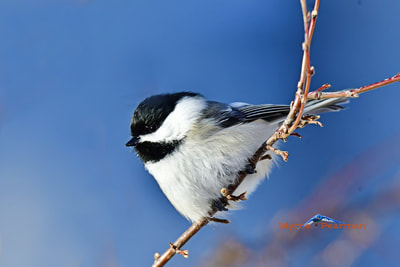 Yesterday was a purely magical spring day. Grandson Tyson, now almost five years old, is obsessed with butterflies and frogs. With his handy little net, he spent at least an hour racing around the yard trying to snag one of the dozens of Milbert's Tortoiseshells that were feeding on the willow trees. Bree, who is two, is frightened of anything that moves. Thankfully, by the end of the afternoon we had cajoled her into liking lady bugs and butterflies. Spiders will take a bit more convincing. We wandered down to a small pond in our back woodlot, savouring the warmth and earthy spring smells. The pond was at first quiet, so we checked around the shallows for frog egg masses. There were no eggs to be seen, but as we stood quietly by the shoreline, one Wood Frog started croaking. Then another and another. And then a few Boreal Chorus Frogs chimed in. Within minutes, a beautiful spring symphony filled the air. As we stood in awe of the sounds, dozens of frogs appeared at the water surface. We soon counted at least 30 pairs of beady frog eyes poking out from their watery world. Most fascinating is that we saw at least 10 Wood Frogs hopping their way from the woods to the water. Wood Frogs overwinter beneath leaf litter, so we were witnessing their spring travels to the breeding pond. These frogs were so intent on mating that they paid us no heed. As Tyson hunted the shallows (he netted 12 frogs!), I laid on the wet cold grass to watch, marvel and photograph the activities. How fascinating it was to see the air sacks pop suddenly from the males' backs as they croaked their prowess to the females. And everywhere, love was in the air: some couplings (the males climb on the backs of the females and release their sperm as the females lays her eggs) were quite civil affairs, with one male sitting quietly on one female for a few minutes. Other trysts seemed to be much more energetic and raucous, and sometimes involved many writhing individuals. I saw matings that involved the male blowing his air sacs, leaping about, and engaged in (I assume by all the splashing and movement) some amorous underwater acrobatics. I hunted in vain for the Boreal Chorus Frogs. These diminutive green frogs sing loud, lusty arias, but they have mastered the arts of both ventriloquism and invisibility. Finally, I noticed one little green spot among the brown cattail litter. There, staring back at me, was a beautiful little individual. I was able to snap a few pics before it hopped out of sight. Only when the sun began to set and hunger set in did we reluctantly say goodbye to the frogs. What a privilege it was to spend three glorious hours enjoying a front row seat at the most engaging, beautiful and wonder-filled symphony ever! 12/4/2018 Alberta Chickadees! Alberta has four species of chickadees. The most common and abundant species, the Black-capped, is found across the entire province and is a faithful patron at backyard bird feeding stations. The less common and more habitat-specific species is the Boreal Chickadee. This brownish version of the Black-capped prefers coniferous-dominated woodlands so is seldom seen in open or prairie areas. The Mountain Chickadee is well named because its range is restricted to the mountains and foothills. It resembles the Black-capped but is easy to identify because it sports a distinctive white eyebrow. The fourth species, the Chestnut-backed, is a rarity in Alberta. A bird of the west coast, these buff-colored chickadees occasionally nest as far east as the Waterton area. Imagine the surprise among the Alberta birding community when a Chestnut-backed Chickadee photo was posted on Facebook by Tom McDonald of Grande Cache in early January 2018. Up until that point, there were only 15 documented records of this species in the province. Then, on January 7th, three individuals were identified at the feeders of Stan and Keltie Masters near Water Valley. I was lucky enough to be able to see and photograph these birds (shown here). The Masters live in a unique area of the province where all three "regular" species occur. What a thrill it was to see all four of Alberta’s chickadee species all at one feeding station. Who knows where else these chickadees might show up, so be sure to keep an eye on the chickadees that come to your feeders. The four species shown are Chestnut-backed (left) and (below) Black-capped, Boreal, Mountain Chickadee. My last column for the Red Deer Advocate ran in March, 2018.
The following is what I had penned as my farewell. This will be my final column for the Red Deer Advocate. Instead of writing a column with supporting images, as I have done since November 2010, I have been asked to submit monthly photos with short captions. I have greatly enjoyed penning these columns over the years and I appreciate the Red Deer Advocate for giving me the opportunity to share my writings with Central Alberta readers. I will continue to share my passion of nature photography in this paper and will continue to write a monthly blog, where more stories and photos (including of this Great Gray Owl) can be enjoyed: myrnapearman.com/blog. |
AuthorMyrna Pearman Archives
August 2022
|
All photos and published works on this website are copyright Myrna Pearman unless otherwise noted.
Re-posting these images or publishing is not permitted without Myrna's written consent.
Copyright Myrna Pearman Publishing 2024- Site design and maintenance by Carolyn Sandstrom
Re-posting these images or publishing is not permitted without Myrna's written consent.
Copyright Myrna Pearman Publishing 2024- Site design and maintenance by Carolyn Sandstrom









 RSS Feed
RSS Feed



29/4/2018
1 Comment